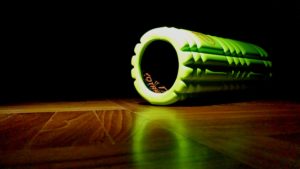We all know that regular exercise and a sound diet are key factors to a healthy lifestyle. We often forget, however, that taking time to recover is just as significant. In addition to adequate sleep, myofascial release is an important part of the recovery process.
The myofascial system includes skeletal muscles and fascia. Latin for “band or bandage,” fascia binds and connects the muscles to the tendons, joints and bones. It can be bound as it shortens, solidifies and thickens as a response to movement, injury or bad habits such as poor posture. This binding can cause stress to the body and result in limited range of motion and pain. Self-myofascial release (SMR) is a self-massage that can be done to release muscle tightness and trigger points (knots). SMR with a foam roller can be an effective way to promote myofascial release and help the body recover from our exercise and daily routines. The deep compression of a foam roller can help break up and relax tight muscles, allowing the return of normal blood flow and restoration of healthy tissue. With regular practice of SMR, a person may experience improved flexibility and suppleness of a muscle, which can therefore lead to less soreness after a workout, quicker recovery of muscles and improved posture.
Before beginning a rolling routine, there are several things to consider and remember:
- Type of roller: There are various types of rollers, so the one you select will depend on your budget and level or experience with foam rolling. Soft density offer light penetration and half rollers offer stability and therefore are ideal for beginners. High/firm density and grid rollers offer a deeper massage and provide more intense myofascial release. These types might be preferred by athletes or highly active individuals.
- Set-up: Allow adequate space and wear appropriate form-fitting clothing (avoid zippers, buttons, belts and pockets). Remove necklaces and tie long hair back.
- Stay hydrated: Drink water before and after rolling. Fascia is 70-80% water, which allows the layers of fascia to glide over each other. Any bound fascia can be considered dehydrated. The pressure of foam rolling opens up the fibers and helps hydrate the fascia.
- Avoid: Rolling over large joints (shoulders, hips, knees) and the lumbar spine. Avoid placing pressure on shoulders, elbows and wrists when rolling.
- Move: Roll in short segments for 10-90 seconds in a specific area. Breathe slowly and deeply as you roll.
- Make adjustments: Like stretching, rolling may be uncomfortable, but should not be painful. If the area is too painful to apply direct pressure, shift and roll in the surrounding area and gradually move to loosen the entire area.
- Be consistent: Like any exercise or diet routine, being consistent is the key to success.
Resources:
Kuhland, Jeff. What is a foam roller, how do I use it and why it does hurt. Retrieved from https://breakingmuscle.com/fitness/what-is- a-foam- roller-how- do-i- use-it- and-why- does-it- hurt Fitour. 2017. Myofascial Release and Self-Massage Techniques for Fitness Professionals
Heid, Markham. February 2017. You asked: Should I use a foam roller? Retrieved from http://time.com/4653956/foam-roller- workout-recovery/
About the Author:
As the Group Exercise Coordinator for BaySport, Lyja provides support to the group exercise instructors, on-site managers and client liaisons. She joined BaySport over 13 years ago as a group exercise instructor, and still enjoys teaching classes today.



